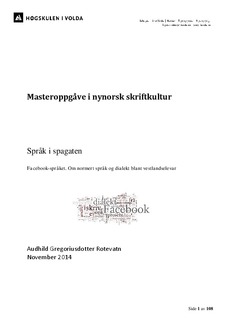Språk i spagaten. Facebook-språket. Om normert språk og dialekt blant vestlandselevar
Master thesis
Permanent lenke
http://hdl.handle.net/11250/2357530Utgivelsesdato
2014Metadata
Vis full innførselSamlinger
- Nynorsk skriftkultur [25]
Sammendrag
Language doing the splits
In 2014 Facebook climbed to the top of the statistics as the largest media channel in Norway for the first time. Facebook is more used than traditional media, like the television channel NRK 1 and the newspaper VG. Facebook is also the only channel in top ten without an editor and where the users themselves produce (and share) the content. At the same time, experts on global media claim that Facebook is the most powerful media channel in the world.
One of the things pointed out in this master's thesis, is that it seems common among young Norwegian Facebook users to choose Norwegian dialects as their most preferred written language, rather than traditional, standardized language. This notion is widely discussed among teachers, parents and the users themselves. But how common is it really, and what are their reasons for choosing to write Facebook messages in dialect? This work is based on 142 informants, all high school pupils aged 18–20, from the West Coast, in the four counties Møre og Romsdal, Sogn og Fjordane, Hordaland and Rogaland. The main focus was to ask them why they prefer to use dialect and in which, if any, other contexts, i.e. SMS, schoolwork, e-mail, applications, and so on, they also prefer to use dialect.
The result of the study shows that Facebook is an important channel for the pupils. All the informants have a Facebook profile, and 90 percent of them use Facebook on a daily basis. A majority uses Facebook more than five times daily, and three out of four use dialect. This was a higher result than expected. The main reason for using written dialect is not that «everyone else does it», but rather: «because this is how I speak».
Norway has not only a large and thriving variety of spoken dialects, but also two standards of written Norwegian: Bokmål and Nynorsk. The majority of informants in this study have Nynorsk as their first language, while the dialects spoken in the four counties differ in many ways and on many accounts.
Although the Language Council of Norway is currently responsible for both planning and maintaining the principles of codifications in both Nynorsk and Bokmål, Nynorsk was originally established as a written language by the Norwegian linguist Ivar Aasen (1813–1896) based on the foundational elements in the variety of dialects spoken in Norway. One could imagine that the pupils choose dialect because they find the grammar in Nynorsk or Bokmål confusing or difficult. Based on the findings in this thesis, however, this can not be claimed to be the case, although the informants with Nynorsk as their first language responded to find the Nynorsk grammar more difficult than Bokmål.
The majority of the informants do not use dialects on all Internet-domains. Also, there are sound arguments as to not seeing all Internet-based forms of communication as homogenous. The pupils use dialect on SMS and social media, like Facebook, Snapchat and Instagram, but not in e-mails, neither in discussions in online newspapers or blogs, and rarely in job applications and schoolwork. It seems that the nature of social media, dialogues written in a quick manner, informal context and heavy use, prepares the ground for dialect as a new standard of writing.
